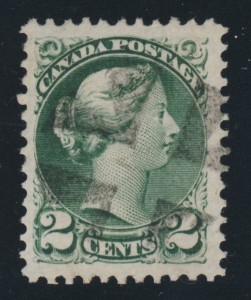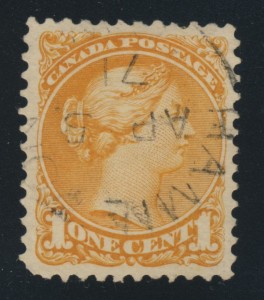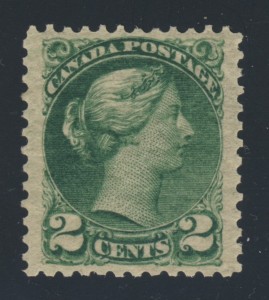 1889 2c green Small Queen, 2nd Ottawa Printing, mint never hinged with full original never hinged gum, minor gum bends, very fine. Accompanied by 2004 Richard Gratton AIEP certificate. Unitrade CV$225, realized $242.
1889 2c green Small Queen, 2nd Ottawa Printing, mint never hinged with full original never hinged gum, minor gum bends, very fine. Accompanied by 2004 Richard Gratton AIEP certificate. Unitrade CV$225, realized $242.
small queen
Highs and Lows
No, we’re not referring to pharmaceuticals.
With only a few days to go we decided to examine the opening bids and look at one high and a bunch of lows.
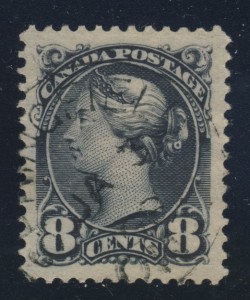
1893 8c violet black Small Queen, selected with precise centering within four oversized margins, light cds cancel, an extremely fine gem. Unitrade CV$6.00
Yesterday I spoke with a customer in the store who asked about this lot and he volunteered that he had bid $40 and wanted to know his chance of success. I told him that I thought he would be the under-bidder. It is now opening at $160 which more than 26 times full catalogue. Unless he has changed his bid he is certainly no longer the under-bidder. I have no idea what the high bid is (it might be $160). I do know there are at least a few lots with already respectable openings where the high bid is quite a bit higher than the current opener. There are also many lots which may or may not have one bid but still show as opening at $2 because there is only one bid on the lot. Here are three groups (and I could have chosen many) which deserve more consideration — and bids — from our customers.
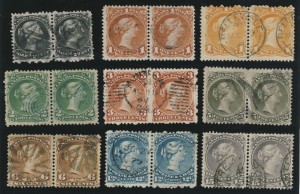
1868-1875 ½c to 15c Large Queen issue, basic set of 9 different values in matched horizontal pairs, used with a variety of cancels including four with cds cancels, the ½c is on thin crisp paper, overall fine-very fine but we note small faults on the 12½c. A difficult group to assemble. Unitrade CV$1940.
A nice complete set of Large Queens in pairs is actually quite difficult to assemble. This lot and from the same consignor Lot 155 which is pairs of the Small Queens are two of the early lots which deserve better than an opening of $2.

Alberta Hunting Stamps 1964-1994, 63 stamps, 26 different. Most are for resident big game, deer, elk, moose and game birds. All used, in mixed condition, as they were affixed to licenses. Listed, but unpriced by Van Dam, largely due to their scarcity. Estimate $750.
A well-researched and extensive book on wildlife and conservation stamps will soon be published. It will open up a whole new area to consider collecting and add many hundreds of items to the listings of modern Conservation stamps which already receive a good philatelic following. Here is an opportunity to get in on the ground floor with this lot. It too deserves better than $2.
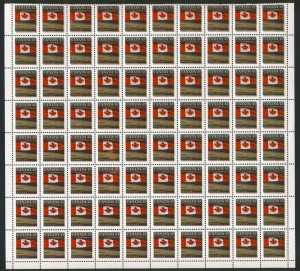
1992 43c Flag over Field, Leigh-Mardon printing, double printed grey cast. During a normal printing run of a high speed web press a double printing is impossible. However in preparation for the high speed press a “make-ready” is often fed through to check for ink registration. On this occasion a make-ready was fed through the press twice resulting in a weak impression and overlaying that with a normal strong impression. Normally make-readys would be destroyed but on this occasion two double printed panes were packaged, sent to Canada Post and sold to an Ottawa resident, who then, upon noticing the variety, sold the top blocks of 20. It is these two blocks of 20 with the doubling most pronounced upon which the Unitrade listing and valuation has been established. This part pane has a double printing with a grey cast. Mint never hinged, very fine. Unitrade CV $160,000. See also Lot 436 (block of 12 with the brown cast, the largest multiple from the top two rows) and Lot 438 (block of 80 with the brown cast).
With a catalogue value of $344,000 for these three lots there will obviously be lots of floor bidding if the opening remains at a paltry $2.
There are many more lows with a few days remaining. The opening bids can be easily accessed through this link to our listing on Stamp Auction Network. Once you see our Auction, click on the button at top left that says Opening Bids.
Certainty and Certificates
The great majority of all stamps can be identified with certainty. When one comes across a stamp which raises questions, however, certainty is often difficult. Questions may concern the catalogue number, whether genuine or not, with or without original gum, with or without postmark, evidence of alterations or repairs, etc. A certificate from a recognized authority can often answer these questions. Certificates are prepared by humans, however, and mistakes can be made between a determination of genuine and not (in either direction!).
Generally speaking one should prefer an opinion which is unequivocal — “is genuine in all respects” or “is a forgery” usually settles the matter. “Appears genuine as far as one can tell” or “no opinion” does not help much. Whole books have been written on the subject.
With this background in mind, we’ll look at two lots in our current auction. Both have certificates from the VG Greene Foundation which is the pre-eminent expert committee for the stamps of Canada and British North America.
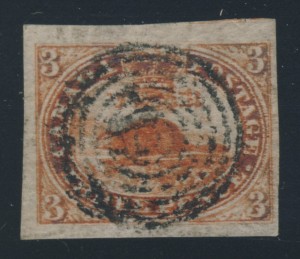
1851 3d red Beaver on laid paper, used with three jumbo margins and fourth well clear of outer frameline. 1978 Greene Foundation certificate mentions a “small hole” which is a pinhole not on this stamp, or in the margin but in the portion showing the next stamp at top right. A very fine example of Canada’s first stamp. Unitrade CV$1600.
A careful reading of our description explains how we interpret the rather unflattering description reading “small hole.” This is an example of a harsh Certificate. A Certificate which might be ambiguous about whether the gum is original would be an example of a generous Certificate. Generally speaking, the Greene Foundation is more likely to give a harsh rather than a generous Certificate.
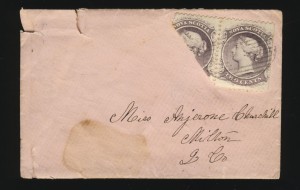
1860 2c lilac, pair one bisected on cover From a new find, backstamped Liverpool, NS APR.22.1868. As the Large Queen issue was introduced in April 1868, many postmasters wished to use up the old Nova Scotia stamps. Three cents was the new Dominion rate. In 2010 the Greene Foundation wrote “the item could be genuine but the lack of a cancel tying the bisect line to cover prevents us from giving an opinion.” Not noted by the Greene Foundation was the lack of evidence of a scoreline in the event someone has used a scalpel or knife to create a bisect and also a faint staining which ties the bisect to the cover. Envelope has a stain and is damaged in upper left and lower left corners. Both stamps have some damage. Unitrade CV$3500.
Here is another example of a lot where we added commentary to the description. I concur with the opinion of perhaps the foremost authority on Nova Scotia postal history that this is genuine. Both of us have examined it thoroughly and have the oral evidence of it being a new find (see also Lot 1269). An April 22 date (the new Dominion stamps were first available April 1) and the fact of a 50% increase in postage at the same time for an in-county Nova Scotia letter suggests that no respectable and frugal correspondent would voluntarily put two of his old colonial stamps on a letter.
However all that background is lost once this envelope changes hands several times. The faint stain which ties the bisect is evidence when the envelope first surfaces but hardly evidence decades from now. The Greene Foundation did not err with its “no opinion.”
For some items a collector has to live without absolute certainty.

